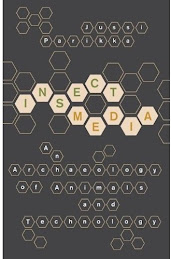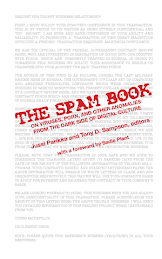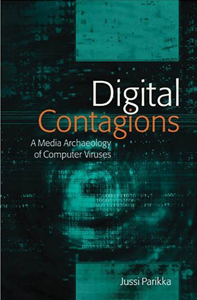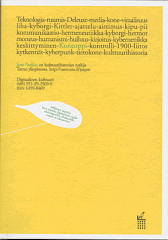Some information on our forthcoming Media Archaeology: Approaches, Applications, Implications-book that we edited together with Erkki Huhtamo, forthcoming Spring 2011 from University of California Press... no cover image yet, and no table of contents online, hence I am posting at least the contents here! For clarity's sake, this is the one that is ready, and I am writing at the moment another book, a single authored one on the same topic.
1. Introduction: An Archaeology of Media Archaeology --Erkki Huhtamo and Jussi Parikka
Part I: Engines of/in the Imaginary
2. Dismantling the Fairy Engine: Media Archaeology as Topos Study --Erkki Huhtamo
3. On the Archaeology of Imaginary Media --Eric Kluitenberg
4. On the Origins of the Origins of the Influencing Machine --Jeffrey Sconce
5. Freud and the Technical Media: The Enduring Magic of the Wunderblock --Thomas Elsaesser
Part II: (Inter)facing Media
6. The “Baby Talkie,” Domestic Media, and the Japanese Modern --Machiko Kusahara
7. The Observer’s Dilemma: To Touch or Not to Touch --Wanda Strauven
8. The Game Player’s Duty: The User as the Gestalt of the Ports --Claus Pias
9. The Enduring Ephemeral, or The Future Is a Memory --Wendy Hui Kyong Chun
Part III: Between Analogue and Digital
10. Erased Dots and Rotten Dashes or How to Wire Your Head for a Preservation --Paul DeMarinis
11. Media Archaeography: Method and Machine versus History and Narrative of Media --Wolfgang Ernst
12. Mapping Noise: Techniques and Tactics of Irregularities, Interception, and Disturbance
--Jussi Parikka
13. Objects of Our Affection: How Object Orientation Made Computers a Medium --Casey Alt
14. Digital Media Archaeology: Interpreting Computational Processes --Noah Wardrip-Fruin
15. Afterword: Media Archaeology and Re-presencing the Past --Vivian Sobchack
[edit 21/12/10]: Endorsement by Sean Cubitt:
"Huhtamo and Parikka, from the first and second generations of media archaeology, have brought together the best writings from almost all of the best authors in the field. Whether we speak of cultural materialism, media art history, new historicism or software studies, the essays compiled here provide not only an anthology of innovative historical case studies, but also a methodology for the future of media studies as material and historical analysis. Media Archaeology is destined to be a key handbook for a new generation of media scholars."
- Sean Cubitt, author of The Cinema Effect
Friday 24 September 2010
Tuesday 21 September 2010
Nauman-cum-Lynch
My perspective to Bruce Nauman television art piece (at the Hamburger Bahnhof, Berlin, September 2010) becoming a David Lynchian experience.
Thursday 16 September 2010
RIP: A Remix Manifesto - film screening and panel discussion

A screening of the fantastic RIP: A Remix Manifesto and followed up by a panel discussion with some leading technology and culture writers, presented by CoDE (as part of the Festival of Ideas):
Arts Picturehouse, Cambridge
October 30, Saturday, 15.00-17.30
Tickets from the Picturehouse ticket counter
"In RIP: A Remix Manifesto, Web activist and filmmaker Brett Gaylor explores issues of copyright in the information age, mashing up the media landscape of the 20th century and shattering the wall between users and producers.
The film’s central protagonist is Girl Talk, a mash-up musician topping the charts with his sample-based songs. But is Girl Talk a paragon of people power or the Pied Piper of piracy? Crea...tive Commons founder, Lawrence Lessig, Brazil’s Minister of Culture Gilberto Gil and pop culture critic Cory Doctorow are also along for the ride."
The screening is followed up by a panel discussion with
- Bill Thompson (technology writer and columnist for the BBC Online, as well as head of partnership development for Archive Development projects at the BBC)
- John Naughton (academic at Cambridge University, writer and columnist for the Observer),
- Becky Hogge (technology writer, columnist for the New Statesman and former executive director of the Open Rights Group),
- Jussi Parikka (media theorist and director of the CoDE-institute at Anglia Ruskin University)
and
- Geoff Gamlen (a founding member of the remix-music/video group Eclectic Method have been called upon by artists like Fatboy Slim & U2 and by film, video, and television companies such as New Line Cinema and Palm Pictures to create custom a/v remixes.)
The panelists address the themes raised by RIP: Remix Manifesto and a range of interesting and provocative approaches to cultural production in the digital age, copyright and its alternatives, and free culture.
Sunday 12 September 2010
Recent books by friends
Some recent books by friends:
Michael G oddard: Gombrowicz, Polish Modernism, and the Subversion of Form (Purdue University Press, 2010)
oddard: Gombrowicz, Polish Modernism, and the Subversion of Form (Purdue University Press, 2010)
Gombrowicz, Polish Modernism, and the Subversion of Form provides a new and comprehensive account of the writing and thought of the Polish writer Witold Gombrowicz. While Gombrowicz is probably the key Polish modernist writer, with a stature in his native Poland equivalent to that of Joyce or Beckett in the English language, he remains little known in English. As well as providing a commentary on his novels, plays, and short stories, this book sets Gombrowicz's writing in the context of contemporary cultural theory. The author performs a detailed examination of Gombrowicz's major literary and theatrical work, showing how his conception of form is highly resonant with contemporary, postmodern theories of identity. This book is the essential companion to one of Eastern Europe's most important literary figures whose work, banned by the Nazis and suppressed by Poland's Communist government, has only recently become well known in the West.
About the Author(s): Michael Goddard After completing his Ph.D. at the University of Sydney, Michael Goddard was employed as Visiting Professor of Cultural and Media Studies at the University of Lodz in Poland, and as Professor of Cultural Studies at Mikolai Kopernikus University, Torun. Since September 2007, he has been lecturer in media studies at the University of Salford in the United Kingdom. He is an active member of the European Network for Film and Media Studies (NECS) and participates actively in a range of international conferences and other academic and cultural events.

Pasi Väliaho: Mapping the Moving Image. Gesture, Thought and Cinema circa 1900
(Amsterdam University Press 2010)
In Mapping the Moving Image, Pasi Väliaho offers a compelling study of how the medium of film came to shape our experience and thinking of the world and ourselves. By locating the moving image in new ways of seeing and saying as manifest in the arts, science and philosophy at the turn of the twentieth century, the book redefines the cinema as one of the most important anthropological processes of modernity. Moving beyond the typical understanding of cinema based on optical and linguistic models, Mapping the Moving Image takes the notion of rhythm as its cue in conceptualizing the medium’s morphogenetic potentialities to generate affectivity, behaviour, and logics of sense. It provides a clear picture of how the forms of early film, while mobilizing bodily gestures and demanding intimate, affective engagement from the viewer, emerged in relation to bio-political investments in the body. The book also charts from a fresh perspective how the new gestural dynamics and visuality of the moving image fed into our thinking of time, memory and the unconscious.
Pasi Väliaho is lecturer in film and screen studies at Goldsmiths College, University of London.
Reviews
A commanding and consummate study of art, philosophy, the human sciences, physics and biology in the matrix of cinema at the turn of the twentieth century. Blending contemporary theory with close readings of the foundational writings of modernity—Freud, Bergson, Nietzsche—Väliaho shows how the autonomy of the movie-machine shapes the ways we believe we think and live today. A broad and compassionate study, Mapping the Moving Image stands high and strong in an impressive body of scholarship on early cinema. It will be a point of reference for every student of cinema, consciousness and perception.
Professor Tom Conley, Harvard University
Michael G
 oddard: Gombrowicz, Polish Modernism, and the Subversion of Form (Purdue University Press, 2010)
oddard: Gombrowicz, Polish Modernism, and the Subversion of Form (Purdue University Press, 2010)Gombrowicz, Polish Modernism, and the Subversion of Form provides a new and comprehensive account of the writing and thought of the Polish writer Witold Gombrowicz. While Gombrowicz is probably the key Polish modernist writer, with a stature in his native Poland equivalent to that of Joyce or Beckett in the English language, he remains little known in English. As well as providing a commentary on his novels, plays, and short stories, this book sets Gombrowicz's writing in the context of contemporary cultural theory. The author performs a detailed examination of Gombrowicz's major literary and theatrical work, showing how his conception of form is highly resonant with contemporary, postmodern theories of identity. This book is the essential companion to one of Eastern Europe's most important literary figures whose work, banned by the Nazis and suppressed by Poland's Communist government, has only recently become well known in the West.
About the Author(s): Michael Goddard After completing his Ph.D. at the University of Sydney, Michael Goddard was employed as Visiting Professor of Cultural and Media Studies at the University of Lodz in Poland, and as Professor of Cultural Studies at Mikolai Kopernikus University, Torun. Since September 2007, he has been lecturer in media studies at the University of Salford in the United Kingdom. He is an active member of the European Network for Film and Media Studies (NECS) and participates actively in a range of international conferences and other academic and cultural events.

Pasi Väliaho: Mapping the Moving Image. Gesture, Thought and Cinema circa 1900
(Amsterdam University Press 2010)
In Mapping the Moving Image, Pasi Väliaho offers a compelling study of how the medium of film came to shape our experience and thinking of the world and ourselves. By locating the moving image in new ways of seeing and saying as manifest in the arts, science and philosophy at the turn of the twentieth century, the book redefines the cinema as one of the most important anthropological processes of modernity. Moving beyond the typical understanding of cinema based on optical and linguistic models, Mapping the Moving Image takes the notion of rhythm as its cue in conceptualizing the medium’s morphogenetic potentialities to generate affectivity, behaviour, and logics of sense. It provides a clear picture of how the forms of early film, while mobilizing bodily gestures and demanding intimate, affective engagement from the viewer, emerged in relation to bio-political investments in the body. The book also charts from a fresh perspective how the new gestural dynamics and visuality of the moving image fed into our thinking of time, memory and the unconscious.
Pasi Väliaho is lecturer in film and screen studies at Goldsmiths College, University of London.
Reviews
A commanding and consummate study of art, philosophy, the human sciences, physics and biology in the matrix of cinema at the turn of the twentieth century. Blending contemporary theory with close readings of the foundational writings of modernity—Freud, Bergson, Nietzsche—Väliaho shows how the autonomy of the movie-machine shapes the ways we believe we think and live today. A broad and compassionate study, Mapping the Moving Image stands high and strong in an impressive body of scholarship on early cinema. It will be a point of reference for every student of cinema, consciousness and perception.
Professor Tom Conley, Harvard University
Labels:
books,
brain,
cinema,
goddard,
gombrowicz,
moving image,
valiaho
Monday 6 September 2010
Read like a cow
Oh we supposedly moderns, we actually think like insects and should read like cows: "...the requisite art of reading, a thing which today people have been so good at forgetting--and so it will be some time before my writings are readable--you almost need to be a cow for this one thing and certainly not a 'modern man': it is rumination..." (Nietzche, On the Genealogy of Modernity, Cambridge UP, 1994, 10).
We don't only dream of animals, but we are caught in a delirium in which we are only part of them. Flying like insects, reading like cows, thinking like bacteria, we do not really have capacities of our own. Human is a fiction invented by the animals, by the soil, by the non-organic as well.
We don't only dream of animals, but we are caught in a delirium in which we are only part of them. Flying like insects, reading like cows, thinking like bacteria, we do not really have capacities of our own. Human is a fiction invented by the animals, by the soil, by the non-organic as well.
Subscribe to:
Posts (Atom)







